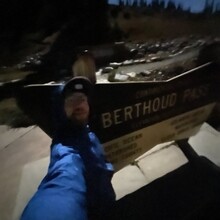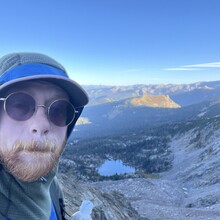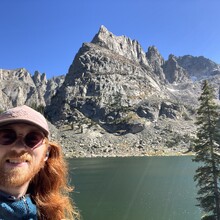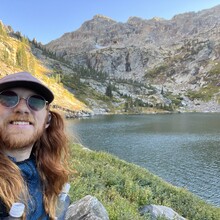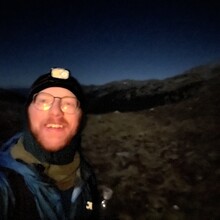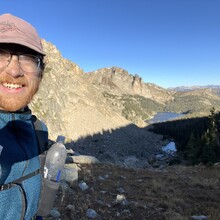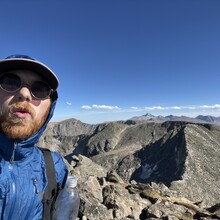I started from Berthoud Pass at 12:30am on 9/18/24. The decision to go northbound was mostly for logistical reasons with start and pick up. The reason for starting so early in the morning was so the two class 3 sections of the route could be approached in the daylight. I was lucky enough to get a good weather window near a full moon, so routefinding in the dark was much easier than expected.
The first 20-25ish miles of the route is a long exposed ridge walk over the highest elevations of the Pfiffner. This is a stretch of ridge that I am very familiar with, and it went by much quicker than I expected. I descended Mount Neva about 7.5 hours into the effort. This first section was not without its challenges though. I was battered by cold, dry wind for the length of the ridge. My water began to freeze up, which could have become a much bigger issue if the sun hadn’t risen, especially with there being no access to water on the ridge. Additionally, the harsh, cold air burned my throat and lungs, causing me to cough up phlegm from my lungs for the rest of the effort. I believe this damage to my lungs was the biggest drag on my pace over the course of the effort. Regardless, I finished this stretch feeling strong and energized by my faster-than-expected pace and the rising sun.
The next section is the core of Indian Peaks Wilderness Area, containing the most technical off-trail sections of the Pfiffner. Climbing up the backside of Hopi Peak to drop into Lone Eagle Cirque took longer than I’d hoped, especially the bushwhack up to treeline. I reached the top of the northeast gully in about 13 hours. While I had climbed up this class 3 gully before, I had never descended it. I found descending this gully to be a much more pleasant experience than ascending it.
The next challenge was Paiute Pass, also class 3. Picking my way through the cliff bands to get to the top was the easy part. I reached the top of Paiute Pass 16h15m into the effort. The hard part of this section, and what felt like the slowest bit of the whole route, was the bushwhack down Thunderbolt Creek on the north side of the pass. I had done this section only once before and in the opposite direction. I regretted not having practiced it a second time more recently and not having taken better notes on the best way to pick through the cliff bands to get down.
My intention was to get a short period of sleep once I reached Upper Lake, but I ended up stopping just above Gourd Lake instead for a few reasons. Firstly, there was a delay between the sunset and the moonrise, and routefinding up to Cooper Peak Pass with only a headlamp was proving to be incredibly slow. Secondly, my energy levels were starting to crash, and I didn’t want to start taking caffeine before getting some shuteye. Thirdly, I passed by a cozy looking rock overhang with a mossy bed underneath, protected from the wind, and I couldn’t pass up the opportunity for such an enticing looking spot to sleep. I was stopped from about 8:40pm to about 12:45am. My sleep was fairly interrupted. I believe I only got about 3 hours of sleep in this period. Nevertheless, I got up refreshed and ready to tackle the next stretch of night hiking.
Cooper Peak Pass and Paradise Pass went by without issue. I entered Rocky Mountain National Park about 26.5 hours into the effort. Bushwhacking through Paradise Park in the dark was slow and required a lot of concentration, which I was starting to run low on, but I was able to get to the other side and up Isolation Peak Pass faster than I expected. As I reached the steep bushwhack up Ptarmigans Beak Pass, the sun began to rise again. I got to the pass overlooking Lake Nanita at 8am, 29.5 hours in.
From Lake Nanita it’s only about 22 miles to the end, most of which is on glorious national park singletrack. This would be my “final push”. I ran down the trail from Lake Nanita to where the Pfiffner reunites with the CDT. I pushed as much as I could up the climb to flattop, taking advantage of the well graded switchbacks. The next descent is where I feel like the exhaustion really starting to take its toll. I was starting to stumble a lot more, and running the easy parts became difficult, even downhill. I reached the junction of the CDT and the trail to Haynach Lakes in 36h15m.
My mental faculties were starting to leave me as I approached the final climb of the Pfiffner, Mt. Ida. I have never struggled more on a climb. Each step up required me to dig deep into my psyche for motivation, and frequent stops to breathe became necessary, especially with my lungs in the shape they were in. The final scramble to Mt. Ida summit may be the hardest I’ve ever had to push myself, my body fighting me with every step. I was totally drained. I got to the top of Ida in 39 hours.
As soon as I reached the summit, before I’d even been able to catch my breath for a second, I was greeted by some dayhikers who asked me to take their picture. I could barely summon a breath to respond, let alone process how to interact with another human in that moment. I mumbled something about how I was being timed and then began to run. Only 4.5 miles left, all downhill on well graded singletrack. After about a mile of “running” (not sure you could actually refer to my stumbling around as running) I had to stop and throw up a little bit. At this point I couldn’t really even run anymore, so I walked as fast as I could manage the rest of the way down, grateful to be able to turn my brain off and let my legs carry me along the singletrack. I made it to Milner Pass in 40h23m.
My goal time for this effort was 40 hours. Missing this time by a mere 23 minutes felt like a bummer at first, however I know that I finished with nothing left to give, and for that I can be proud.

